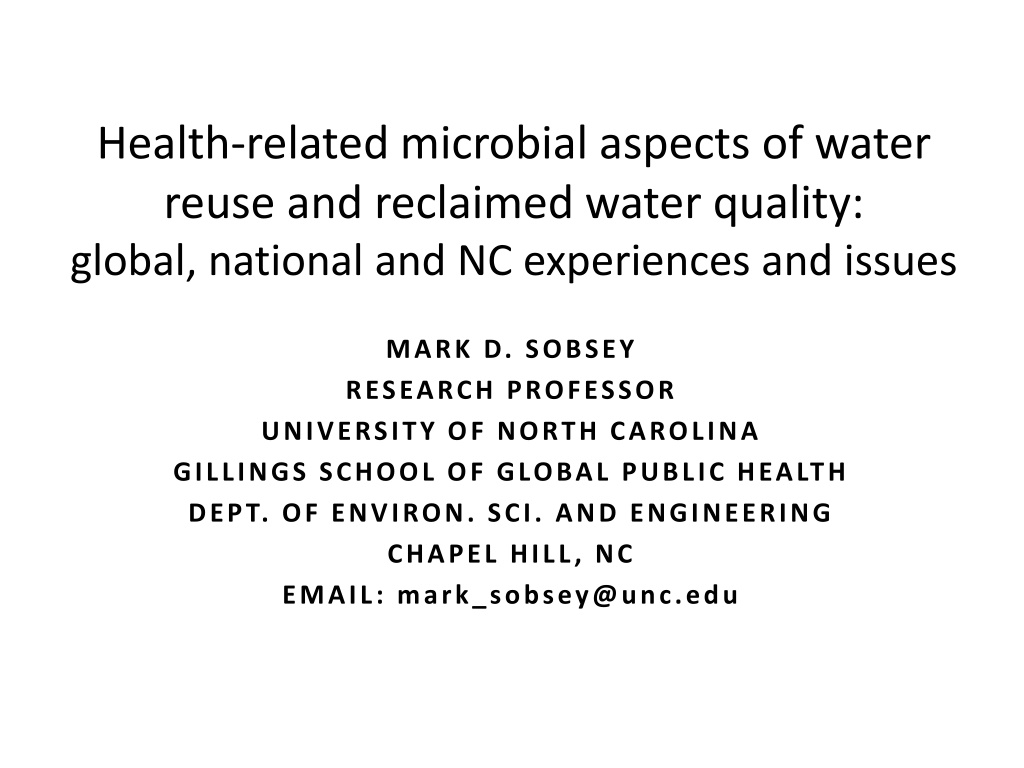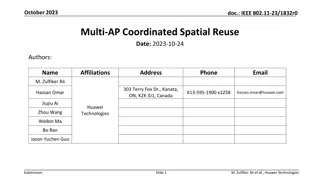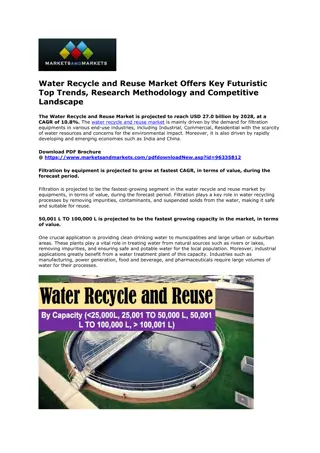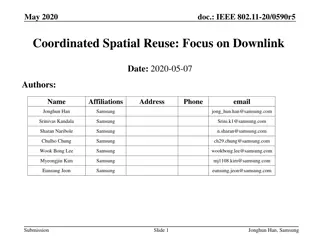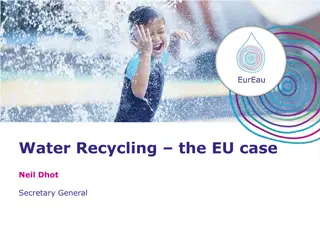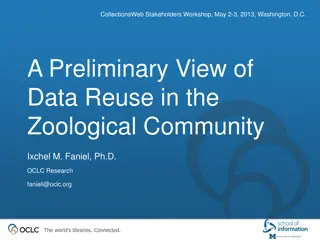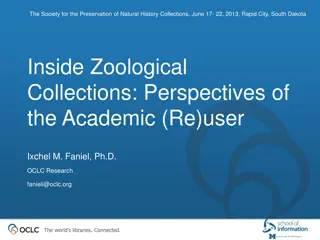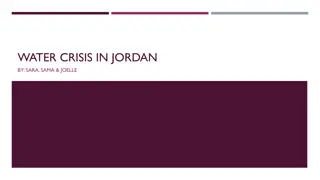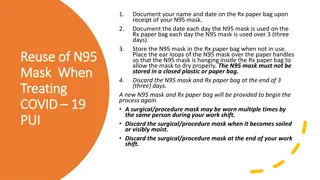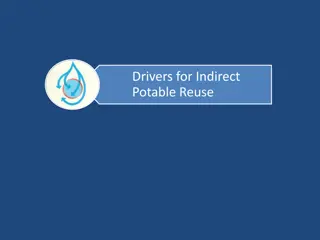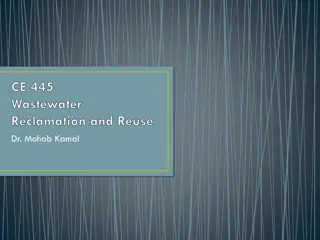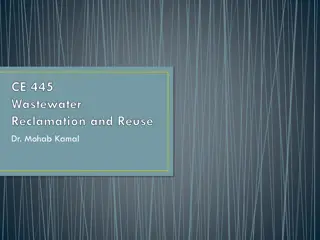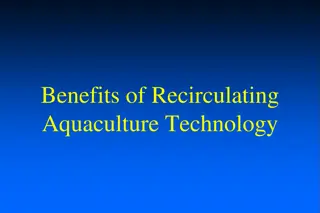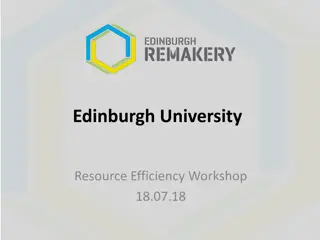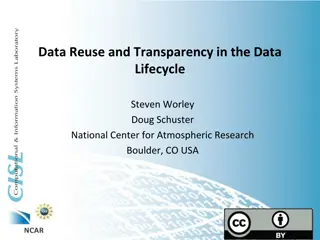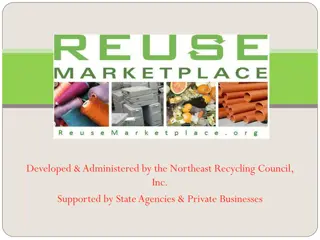Understanding Health Risks in Reclaimed Water and Water Reuse
Exploring the microbial aspects of reclaimed water and wastewater reuse is crucial for public health. Pathogenic microorganisms present in wastewater, such as bacteria, viruses, and parasites, can lead to gastrointestinal and systemic illnesses in humans. Proper removal and inactivation of these pathogens are essential to protect sensitive populations and prevent health risks associated with drinking water, agricultural reuse, and recreational water sources. Various contaminants, including microbial, chemical, and radiological, pose health concerns in wastewater. Pathogens from fecal microbes can cause human diseases through environmental exposures, emphasizing the importance of proper sewage collection, containment, and treatment.
Download Presentation

Please find below an Image/Link to download the presentation.
The content on the website is provided AS IS for your information and personal use only. It may not be sold, licensed, or shared on other websites without obtaining consent from the author. Download presentation by click this link. If you encounter any issues during the download, it is possible that the publisher has removed the file from their server.
E N D
Presentation Transcript
Health-related microbial aspects of water reuse and reclaimed water quality: global, national and NC experiences and issues MARK D. SOBSEY RESEARCH PROFESSOR UNIVERSITY OF NORTH CAROLINA GILLINGS SCHOOL OF GLOBAL PUBLIC HEALTH DEPT. OF ENVIRON. SCI. AND ENGINEERING CHAPEL HILL, NC EMAIL: mark_sobsey@unc.edu
HEALTH-RELATED MICROBIAL ASPECTS OF RECLAIMED WATER AND WATER REUSE Wastewater has high concentrations of pathogenic microorganisms, including bacteria, viruses and parasites They cause gastrointestinal and systemic illnesses in humans Concentrations can be up to 1012 per liter of untreated wastewater Removal and inactivation of pathogens is important because of increasing sensitive populations (20-25% of US population) Reducing pathogen risks from drinking water, non-potable reclaimed water for agriculture and other uses and for discharge to recreational and drinking source waters is essential for public health.
Wastewater Contaminants of Health Concern Microbial Bacteria: E. coli 0157, Campylobacter jejuni. Salmonella, Shigella, Legionella Viruses: Noroviruses, Adenoviruses, Rotaviruses, Enteroviruses, Hepatitis A Virus, Astroviruses Protozoan Parasites: Cryptosporidium, Giardia, Microsporidia Chemical and Radiological Inorganic Chemicals Metals and Metalloids: Lead, Mercury, Chromium, Arsenic Salts: Total Dissolved Solids, Manganese salts, metal salts Oxyhalides: Bromate, Chlorite, Chlorate, and Perchlorate Nutrients: Nitrogen and Phosphorous Radon Organic Chemicals Often measured as TOC but now also by advance spectrometry for the many different ones
Fecal Microbes Causing Human Disease (Pathogens) Can Lead to Environmental Exposures Via Various Routes or Pathways Water Wastes Food Fomites Air Soil Sediment Vectors To prevent exposures, we collect, contain and treat sewage to remove and destroy its pathogens
Fecal Pathogens are Present in Different Microbe Groups Viruses: smallest (0.02-0.3 m diameter); simplest: nucleic acid + protein coat Bacteria: 0.5-2.0 m diameter; prokaryotes; cellular; simple internal organization; multiply by binary fission. Protozoa: most >2 m- 2 mm; eukaryotic; uni- cellular; wide range of sizes and shapes; hardy cysts, oocysts or spores; some have complex life cycles Helminths (Worms): multicellular animals; some are human parasites; eggs are 25-150 m; some have complex life cycles (too big to show at scale on this graphic) Pathogens differ in occurrence, survival, resistance to water and waste treatment, infectivity and health effects
Brief (and Selective) History of Reuse 1910s- 20s: US State parks in AZ and CA begin using reuse water to supply ornamental lakes, water lawns, and to flush toilets. (Grand Canyon Nat l Park) 1930s: San Francisco uses secondary-Rx d. water to irrigate Golden Gate Park 1942: Baltimore, MD - Bethlehem Steel Co. uses reclaimed water for metals cooling and steel processing. 1960: City of Colorado Springs, CO - reclaimed water used for landscape irrigation of golf courses, parks, cemeteries & freeways. 1962: Los Angeles County, CA uses groundwater recharge via spreading basins. 1968:Windhoek Namibia uses advanced direct wastewater reclamation system to augment potable water supply. 1969: Wagga Wagga, Australia uses landscape irrigation of sporting fields, lawns, and fields. 1976: Orange County, CA uses groundwater recharge by direct injection. 1977: Israel uses groundwater recharge by basins for unrestricted crop irrigation 1980s: Australia uses reclaimed water for private homes. Toilets.
Background on Reclaimed Water Uses Benefits of Use Use Category Type of Use Issues with Use Landscape Irrigation Parks, athletic fields, playgrounds, cemeteries, golf courses, school grounds, lawns Dual distribution system Uneven seasonal demand High TDS can affect plant health Cost savings Expand water resources Increase resiliency to climate impacts Decrease use of drinking water for non-potable uses Reduce need for chemicals Decrease wastewater discharge Environmental and ecosystem benefits Agricultural Irrigation Crops (food, fodder, fiber, seeds), nurseries Use level and source distance Dual distribution system Uneven seasonal demand High TDS can affect plant health Nonpotable urban uses Toilet flushing, fire protection, chiller water, vehicle washing Dual distribution system Building level dual plumbing Need for cross connection and contamination control Groundwater Recharge Aquifer storage and recovery, seawater intrusion control Appropriate conditions needed High level of treatment may be required Potential for water quality degradation in subsurface Potable Water Supply Augmentation Water supply treatment and source blending High level of treatment required Requires post-treatment storage Can be energy intensive
Addressing Microbial Health Risks of Water Reuse Resulting from Reclaimed Water Use and Human Exposures Key Goal: Reduce Risks from Pathogens to Tolerable Levels Approach: Quantitative Microbial Risk Assessment (QMRA) Pathogen levels in sources (e.g., sewage) Pathogen reductions by treatment processes (e.g., Log10 or % reductions) Achieve tolerable level of pathogen risk in water to which people are exposed
Fit for Purpose Treatment and Reuse A Watershed Scale One Water and One Health Approach is Recommended by EPA (from the 2019 EPA National Water Reuse Action Plan Draft) https://www.epa.gov/sites/production/files/2019-09/documents/water-reuse-2019-appendix-a.pdf
Microbial Reduction Goals for Reuse and Potable Reuse Treatment Processes Goal:Reduce microbe concentrations by specific log10 values (LRVs) or percentages to achieve allowable microbe concentrations of tolerable risk from exposures Treatment: Often by a series of physical, chemical and biological processes (1o, 2o, 3o, 4o), with some combination of: Primary and secondary treatment followed by: Advanced membrane treatment (ultrafiltration, microfiltration, reverse osmosis) or alternative filtration processes Disinfection using chlorine, UV, ozone, etc. Combining with surface waters (protected surface water, well water, etc.) or ground water Further storage time and dilution for additional microbial reductions
Estimated LRVs for Wastewater Treatments Processes WHO. 2017. POTABLE REUSE. GUIDANCE FOR PRODUCING SAFE DRINKING-WATER
Assessing Risk and Microbial Data Needed Important questions: How is wastewater treated? What is the recommended type of disinfection? How will the reclaimed water be used? What are the water quality requirements? Microbial quality usually determined by concentration of indicators, rather than pathogens of public health interest. Preferred data needed Relationship between potentially regulated indicators and pathogens of public health interest. Or data on pathogens, preferably on infectivity (viability) to assess microbial risk related to potable or other human ingestion reuse. Data Analysis QMRA to estimate risk and compare to acceptable risk levels US EPA drinking water exposures: 10-4 risk of infection/person/year.
Important Health-Related Microorganisms Indicators: Pathogens: Variable Presence Low/Varying Concentrations Difficult to detect Always in fecal waste High concentrations Easy to detect and quantify Bacteria E. coli or Fecal Coliforms (FC) Enterococcus spp. Viruses Somatic Coliphage F+/male-specific Coliphage Total Coliphage Protozoan Parasites Clostridium perfringens (all) Clostridium perfringens spores Bacteria Salmonella spp., Campylobacter spp. Viruses Adenoviruses Noroviruses Rotaviruses Protozoan Parasites Cryptosporidium spp. Giardia spp.
CURRENT WATER REUSE GUIDELINES - WHO Key Goal: Reduce Risks from Pathogens to Tolerable Levels World Health Organization Guidelines Address health risks of viruses, bacteria and parasites Risk based on Disability Adjusted Life Years (DALYs) as standard metric DALYs differ among different pathogens, based on risk of infection, illness and severity of illness. Can be converted to risks of infection or illness for specific pathogens Risks differ and vary among the pathogens Consider worst cases Wastewater Reuse in Agriculture (2006) Risk based on DALYs), LRVs for different crops, treatments and uses and also concentrations of FCs and helminth ova Potable reuse for drinking water (2017) LRVs of 9.5 for viruses and 8.5 for bacteria and parasites Also must meet all WHO Guidelines for Drinking-water Quality Microbial reductions to reduce risks to tolerable levels Can relate to needed LRVs of specific pathogens Standard risk metric is DALY
CURRENT WATER REUSE GUIDELINES INTERNATIONAL STANDARDS ORGANIZATION (ISO) ISO has standards for viruses, bacteria and parasites in reclaimed water and biosolids of commercial, , turnkey sanitation systems LRV and microbial concentration standards for viruses, bacteria, protozoan parasites and helminths in treated liquids and solids Treated liquid effluent: Treated liquid effluent LRVs: 7 viruses, 6, bacteria, 6 protozoans, 4 helminth ova; low allowable concentrations ISO 30500. Non-sewered sanitation systems Prefabricated integrated treatment units General safety and performance requirements for design and testing. 2018
CURRENT WATER REUSE MICROBIAL GUIDELINES - USA No uniform national standards for water reuse in the USA Potential via the Clean Water Act and Safe Drinking Water Act New efforts by EPA to update reuse guidance since 2012 State level regulations vary among different states California: Most stringent standards 12-10-10 log10 reduction (LRV) rule for viruses; bacteria; and protozoa for treated wastewater intended for IPR; Texas has similar guidelines for DPR North Carolina: Less stringent; does not include water Rx LRVs 2 different reclaimed water categories: types 1 and 2 Type 1, less strict quality: <14 FC/100 mL GM; 25/100 mL max./sample Type 2: 6-5-4 LRVs of E. coli; coliphages; and C. perfringens GM/single max. concentrations: 3/25 for E. coli or FC, 5/25 for coliphages or Clostridium perfringens For potable use, requires reclaimed wastewater to be blended with source water at 1:3 ratio prior to conventional drinking water treatment
NC Type 2 Reclaimed Water (NCT2RW) Tertiary treatment then dual disinfection (UV and Chlorine) Potable reuse: up to 20% combination of reclaimed water with surface source water + 5 days of storage http://www.owasa.org/wastewater-management
Rationale and Need for Reuse Research in NC Tertiary treated, dual disinfected reclaimed water has not been evaluated adequately for microbial quality in typical full-scale production scenarios. NCT2RW has not been studied for microbial quality when blended with surface source waters and stored for 5 days. There is a need for real-world data that documents the microbial quality, microbial reduction performance and assessment of microbial risk of NCT2RW.
Microbial Quality of NCT2RW for 4 NC Treatment Facilities: Study Aims Quantify indicators and pathogens in raw sewage and reclaimed water samples Evaluate the log10 reductions for NCT2RW producing treatment facilities Assess pathogens risks from human exposures for use as produce irrigation water and drinking water
Average Bacteria Log10 Reductions Log10 Reductions of Bacteria from Raw Sewage to NCT2RW 7 Log10 Reduction per 100mL 6 5 4 3 2 1 0 E. coli* Enterococcus spp.* Salmonella spp. Microorganism = Detection Limit Value NC Reduction Target: 6 log10
Average Virus Log10 Reductions Log10 Reductions of Viruses from Raw Sewage to NCT2RW 5 Log10 Reduction per 100mL 4.5 4 3.5 3 2.5 2 1.5 1 0.5 0 Somatic Coliphage* F+/Male Specific Coliphage* Total Coliphage* Adenovirus A-F Infectious Adenovirus Norovirus GII Microorganism = Detection Limit Value NC Reduction Target: 5 log10
Average Protozoan Parasite Log10 Reductions Log10 Reductions of Protozoan Parasites from Raw Sewage to NCT2RW Log10 Reduction per 100mL 5 4.5 4 3.5 3 2.5 2 1.5 1 0.5 0 C. perfringens (Pasteurized) C. perfringens (Total) Cryptosporidium spp. Giardia spp. Microorganism NC Reduction Target: 4 log10
Key Risk Assessment Results Potable Reuse Risks were not reduced below the US EPA acceptable level for drinking water exposures for pathogens. Adenovirus risks were the greatest in potable reuse waters. Agricultural Reuse Risks were reduced below the WHO acceptable DALY level for agricultural reuse waters pathogens using subsurface drip irrigation. Risks from protozoan parasites, due to their presence in reclaimed waters and their survival on fruits and vegetables, were the greatest based on this analysis. Lower volumes of irrigation water, from subsurface drip irrigation, reduced risks.
Future Needs and Directions More health-related microbial studies of NC Type 2 reclaimed water are needed. Existing plants producing NC type 2-like reclaimed water need to improve or optimize treatment to further reduce pathogens. Longer term studies at more NC facilities producing NC type 2 reclaimed water are recommended, especially for plants wanting to become certified for this grade of reclaimed water.
